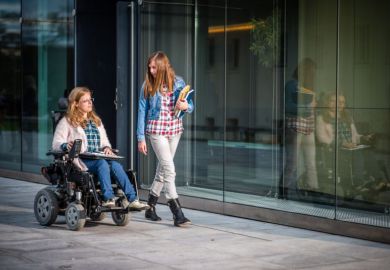Disability groups are demanding the retraction of part of the Australian Universities Accord’s final report, claiming that its “ableist language” and “data faults” risk disadvantaging millions of potential students.
In a joint statement, 10 representative groups have asked the Education Department to remove the term “profound disability” from the report and insert a target participation rate for students with disabilities.
The report recommended aspirational participation targets for indigenous, regional and socioeconomically disadvantaged students, but not people with disabilities. It said people with disabilities already appeared to have exceeded their “expected enrolment share” of 8.4 per cent, so no increase was warranted.
“After decades of progress for people with disability, particularly towards increased participation in society and in higher education, the accord’s assertion that no further work is needed to improve the representation and experiences of people with disability in higher education is extremely disappointing,” the statement says.
The 8.4 per cent figure is an Education Department estimate based on data that excludes people with “profound disability” because it “is assumed to preclude participation in higher education”, the report says.
Campus resource collection: Making your campus neurodivergent friendly
Disability representatives are incensed at the exclusion of people with profound disability, defined as those needing help with self-care, mobility or communication. “Have we just assumed away the next Stephen Hawking?” tweeted Rosemary Kayess, a quadriplegic legal academic who was recently appointed national disability discrimination commissioner.
“It’s a profound misunderstanding of the data and the definitions of disability,” said Graeme Innes, a blind lawyer, now chancellor of Central Queensland University. “The accord document basically says that we’re at parity in terms of students with disability, so we don’t need to do any more. That’s just clearly wrong. This is a huge setback for people with disabilities...because universities will [think], ‘we’ve ticked that box’.”
Dinesh Palipana, an emergency doctor who was paralysed in a car accident during his medical studies, said the “important work” people with profound disability performed for Australian society was at risk of being squandered because of assumptions that they could not handle higher education.
“The reality is people can and do,” said Dr Palipana, who is also a spinal injury researcher and senior lecturer at Griffith University. “We need to set expectations higher.”
The Education Department said its modelling had been based on “the population considered most likely to be attending university”.
“We acknowledge that this might not be the right approach,” a spokesman told Times Higher Education. “We can and should continue to look for ways to support access for students from all backgrounds, including those with disability, to participate in greater numbers.”
Critics also say the 8.4 per cent estimate is absurdly low, given that 24.2 per cent of Australian school students were given special consideration last year for their disabilities. The Australian Bureau of Statistics estimates that around 18 per cent of the population have disabilities.
While 11.4 per cent of domestic undergraduates had disabilities in 2022, according to Education Department data, the proportion is around 20 per cent at several universities. Disability advocate Darlene McLennan said the figures had soared in 2023 as more students sought support – particularly for mental health conditions.
“We’re already hearing from disability teams in universities [that] their v-cs are saying, ‘we don’t need to worry about people with disabilities any more because we’re well over that parity level’,” said Ms McLennan, manager of the Australian Disability Clearinghouse on Education and Training. “It is going to have an impact if we aren’t clear about the data.”
Critics say the disability community has been sidelined in other ways. For example, the report recommends the appointment of a first nations commissioner and an equity commissioner, but no disability commissioner.
The joint statement calls for people with disability expertise and experience to have a role in implementing the accord’s recommendations, and for the proposed National Student Ombudsman to be given specific responsibility for students with disabilities.
Register to continue
Why register?
- Registration is free and only takes a moment
- Once registered, you can read 3 articles a month
- Sign up for our newsletter
Subscribe
Or subscribe for unlimited access to:
- Unlimited access to news, views, insights & reviews
- Digital editions
- Digital access to THE’s university and college rankings analysis
Already registered or a current subscriber?










